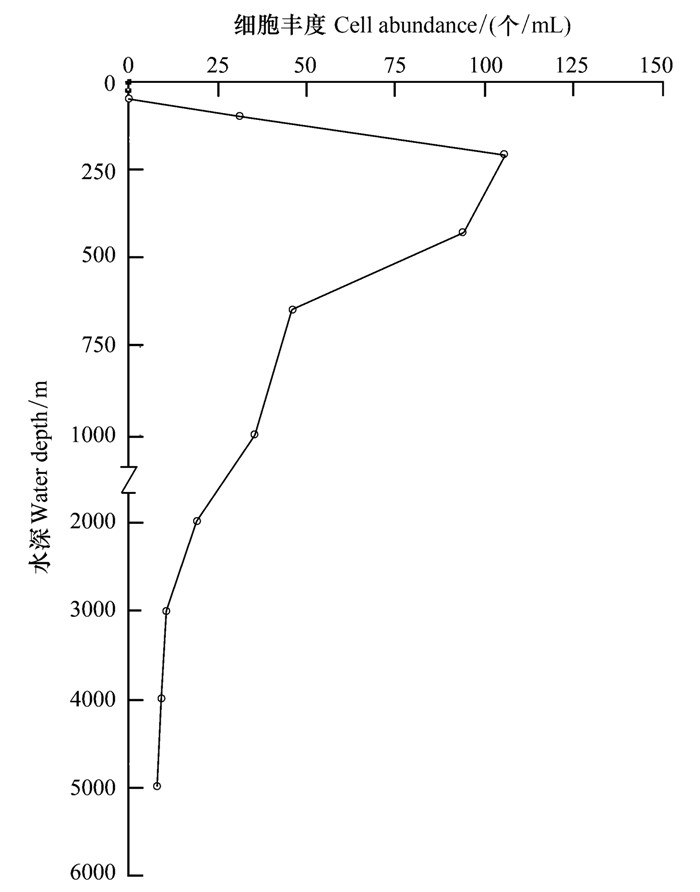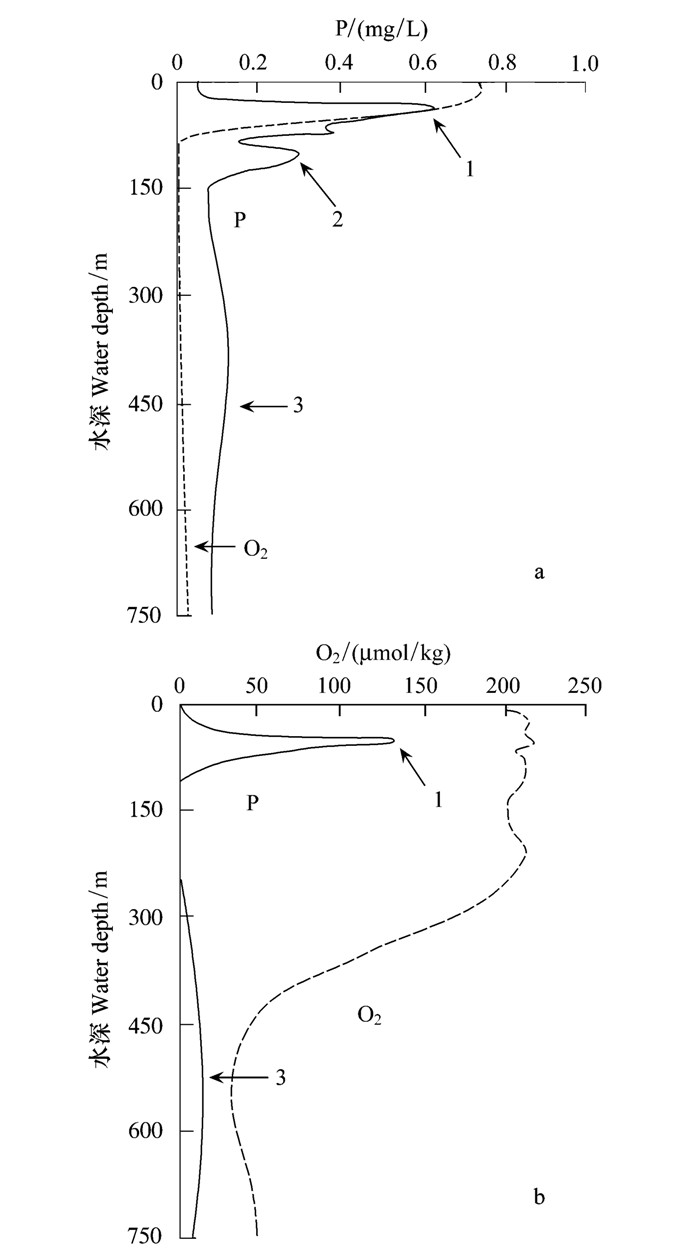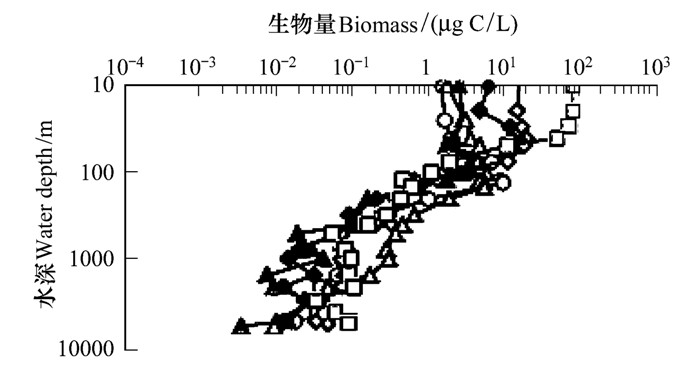文章信息
- 张武昌, 李海波, 丰美萍, 于莹, 赵苑, 赵丽, 肖天, 孙军
- ZHANG Wuchang, LI Haibo, FENG Meiping, YU Ying, ZHAO Yuan, ZHAO Li, XIAO Tian, SUN Jun
- 深层海洋浮游植物研究综述
- Phytoplankton in the deep sea, a review
- 生态学报, 2014, 34(14): 3820-3826
- Acta Ecologica Sinica, 2014, 34(14): 3820-3826
- http://dx.doi.org/10.5846/stxb201306011264
-
文章历史
- 收稿日期:2013-6-1
- 修订日期:2014-5-14
2. 中国科学院大学, 北京 100049;
3. 天津科技大学海洋科学与工程学院, 天津 300457
2. University of Chinese Academy of Sciences, Beijing 100049, China;
3. College of Marine Science and Engineering, Tianjin University of Science & Technology, Tianjin 300457, China
深层海洋是指水深大于200 m的区域,平均水深3800 m,最大水深10924 m,位于马里亚纳海沟。深层海洋的面积为360×106 km2,约为地球表面积的一半,体积为1368×106 km3[1]。深层海洋的浮游生态系统是目前海洋生态学研究的热点之一,认识深层海洋中浮游生物的丰度和生物量是理解这个生态系统的重要一步。
对深层海洋生物的探索起始于19世纪70年代,1872—1876年,英国调查船“挑战者号”在环球航行中到访过的每处海底都发现了动物,船长Charles Wyville Thomson在1877年发表的航次报告中指出海洋中的生命只分布在两个区域,一个是表层海水,一个是海底附近的海水,位于这两个区域中间的中层海水,基本上没有动物[2]。此后,这个中间层中是否有生物一直存在争论,直到1910年,John Murray和Johan Hjort乘Michael Sars调查船在北大西洋的调查发现中间层的确有很多动物。从此海洋中层存在生物不再受到争议,各国展开了对深层海洋浮游生物的调查[3]。
深层海洋生物的营养来源是从真光层沉降的生物和非生物颗粒,浮游植物需要阳光进行光合作用,所以最初认为浮游植物沉降后会很快降解,不会存活。但是在对深层海洋的探索中,人们在深层发现了有活性的浮游植物[4],后来又发现蓝细菌[5]。
随着我国海洋科学研究的发展,深层海洋浮游生物的研究成为我国海洋浮游生物研究的前沿。本文即综述深层海洋浮游植物(或疑似浮游植物)的研究进展,为我国的深层海洋浮游生物研究提供参考。
1 浮游植物(>2 μm)在浮游生物研究的早期就提到了深层海洋的浮游植物(>2 μm),如Marenzeller和Grobben[4]和Schutt[6],一些浮游植物倾向于生活在真光层底部或光很弱的水层,这些浮游植物被称为荫生植物(shade flora)。根据对地中海的认识,这些生物分布在30—500 m水层,Lo Bianco[7]给出一个专有名词——嫌光性浮游生物(knephoplankton)。
更深入的研究起始于Chun领导的Valdivia调查船在1898—1899年进行的大西洋和印度洋的调查。在这次调查中,著名的陆地植物学家Schimper教授使用可闭合的网具采集深层的浮游生物[8]。后来在地中海[9]、日本东北海区[10]、大西洋和太平洋[11]、地中海东部[12]和红海[13, 14]的深层海洋(最大深度>4000 m)也发现了浮游植物[14]
Sournia[15]总结了以往研究中出现的荫生植物名录,列入名录的标准是至少被两位作者提及且与其他作者没有明显的不一致。按照这个标准,共有荫生植物硅藻(Bacillariophyceae)4种(Gossleriella tropica,Planktoniella sol,Rhizosolenia castracanei,R. temperei),甲藻(Dinophyceae)10种(Ceratium gravidum,C. incisum,C. longissimum,C. platysorne,C. praelongum,C. ranipes,C. vulture,Heterodinium scrippsii,Pyrocystis pseudonoctiluca,Triposolenia truncata),青绿藻(Prasinophyceae)1种(Halosphaera viridis),颗石藻(Prymnesiophyceae)3种(Florisphaera profunda,Oolithotus fragilis,Thorosphaera flabellata)。这些生物粒级从1 μm—1 mm,形状各异,没有发现趋同进化的趋势。
用拖网方法获得的深层海洋浮游植物的丰度很低,因此除了种类的信息外,很少有丰度的信息。Nel[16]在西南印度洋两个站位的500—3000 m水深拖网得到的丰度资料是以每个样品为单位,不是以体积为单位。Okada和Honjo[17]在北太平洋到中太平洋(沿155 °W断面)的200 m以深也发现了一些颗石藻,但是丰度很低,不足以用来研究群落组成。
Marshall[18]可能是第1个检测深海浮游植物丰度的学者,在马尾藻海西北部的两个站位,在20号站采水到6100 m,在26号站采水到2000 m。每层取水样500 mL,沉降浓缩到10 mL。在20号站,1500—6100 m之间没有发现浮游植物,在200—1500 m 之间,颗石藻在各个水层(200、250、300、400、500、600、800、1000、1200和1500 m)都有分布,丰度为240—2220个/L(最大值在500 m),硅藻只在200 m水层有发现,丰度为240个/L,甲藻在400 m水层有发现,丰度为480个/L,其他类群在200—600 m之间有发现,丰度为120—320个/L,浮游植物总丰度为240-2220个/L(最大值在500 m)。在26号站,1000—2000 m之间没有发现浮游植物,在200—1000 m之间,颗石藻在各个水层(200、250、300、500、800和1000 m)都有分布,丰度为60—480个/L(最大值在500 m),硅藻仅在300 m有发现,丰度为60个/L,没有发现甲藻,其他类群只在200 m有发现,丰度为220个/L,浮游植物总丰度为60—480个/L(最大值在500 m)。Subba Rao和Sameoto[19]在哥斯达黎加附近的太平洋的200—1000 m水深用孔径为30 μm的BIONESS网进行分层拖网,发现硅藻和甲藻的总丰度为1—96个/L。
在深层海洋的不同深度采集到的浮游植物细胞是否具有活性备受关注[20],在4300 m采集到的硅藻Nitzschia seriata在船上培养成活[11]受到质疑[20]。Platt等[21]在哥斯达黎加附近的热带太平洋,950—1000 m 水深处用孔径为30 μm的BIONESS拖网,发现和水深10 m处同样的硅藻和甲藻,培养结果表明,它们的固碳能力与表层浮游植物相近,异养实验证明这些细胞没有进行异养作用。
浮游植物在深层海洋不能进行光合作用[14]。浮游植物细胞在深海的黑暗状态下生存,需要消耗自己储存的有机物或进行异养作用。Wood[22]的实验证明,海洋表层的硅藻在500个大气压下可以进行异养作用并生长,但是,典型的自养型浮游硅藻在黑暗中不进行异养作用[23],而是消耗自己的有机物。浮游植物在黑暗中存活的时间因种而异[24],大多只能存活20—30 d甚至90 d,存活最长的是羽纹硅藻,可以存活24周[25]。
深层海洋的浮游植物是从水体上层沉降到深层的,如果自己沉降,要花费很长的时间才能到达采集的深度,根据已有的资料,这些细胞在黑暗中不可能存活这么长时间。所以深层海洋的浮游植物可能通过其他方式(如细胞结团、浮游动物粪便[26]及下降流[20, 21, 27]等)快速沉降。
深层海洋的硅藻可能处于休眠状态[28]。硅藻与其他藻类不同,有些硅藻可以不发生形态的变化在生长期和休眠期之间进行转换。硅藻在深层海洋的休眠状态可能是生活史的重要组成部分,具有重要的进化意义。
深层海洋的浮游植物的归宿还没有研究,但大多数深层硅藻不可避免会归于死亡,只有少数能回到海洋表层延续种群[28]。
2 橄榄绿细胞Lohmann[29]在地中海用离心的办法收集了一些球形的细胞,当时没有命名。Hentschel[30, 31]在大西洋、Schiller[32]在亚得里亚海使用没有固定的离心的样品发现了类似的微型生物,分别命名为橄榄绿细胞(Olivgrune zellen)和绿色细胞(Grungelbe zellen)。Hasle[33]采用Utermhl方法在甲醛固定的样品中也发现了这些生物,在显微镜下呈棕色,但未观察到内部结构。Hentschel[30, 31]认为是蓝藻,由于不太确定,就命名为橄榄绿细胞(olive green cell),使用醋酸洋红染色,没有发现细胞核的染色反应。
Fournier[34]将300—1000 mL海水中的生物过滤到Millipore滤膜(孔径0.45 μm)上,用光学显微镜放大1500倍观察计数,在1000 m以深的海水中发现了一些细胞,主要是直径3—5 μm的球形细胞,具2根鞭毛,蓝绿色,细胞内有很多半透明的物质,初步定名为金藻(Chrysophyta)。Hamilton等[35]在加利福尼亚沿岸3400 m的海水中也发现了直径1—4 μm的类似的具色素的细胞。
Fournier[36]用电镜分析了这些细胞,发现可以分为3个类群,第一类细胞直径为2.5—15 μm,结构很简单,和原核生物类似,在琼脂上培养4个月,这些细胞既不生长也不腐败;第2类细胞直径为1.3—2.5 μm,属于真核生物,具叶绿体,丰度较低;第3类细胞混合了很多类群,个体较少,无法鉴定种类。Fournier[36]认为这3个类群就是橄榄绿细胞。
在Hentschel[30, 31]、Schiller[32]及Hasle[33]的研究中,这些生物分布在大洋的深层(150 m以深,最深可达5000 m),丰度不超过1600个/L。而Fournier[23, 36] 所报道的丰度远远大于这个数值,平均为80000个/L,最大为220000个/L。这些细胞的沉降速度为2.6 cm/d,1年大约沉降10 m[37],所以Fournier[34, 36, 37]认为离心富集和Utermhl沉降的方法不能有效收集这些细胞。
Hentschel[31]在北大西洋和南大西洋的数据和Fournier[36, 37]在地中海和北大西洋的数据虽然不同,但是垂直分布趋势是一致的,即:表层没有,在50 m开始出现,在真光层的丰度较低,丰度随水深逐渐增加,最大丰度出现在水深200—1000 m(大多在300—500 m之间),随后逐渐减少(图 1)。
Fournier[36]解剖采自2000—4000 m的10只桡足类浮游动物,在3只的肠道中发现了这些细胞,Fournier[38]在亚热带太平洋真光层中采到的背囊类和樽海鞘的肠道中没有发现这些细胞,而在真光层到750 m采到的个体体内发现了这些细胞,说明这些细胞可以被桡足类等浮游动物摄食。
这些细胞可能并不是完整的细胞,而是浮游植物碎片。Anderson[39]认为这些细胞可能是硅藻休眠细胞的碎片,他把从870 m海水中分离培养得到的硅藻(咖啡形双眉藻Amphora coffaefromis)放入黑暗中在7 °C保持4周,这些硅藻细胞会产生休眠细胞。这些休眠细胞在光照下48 h内,会变形产生球形的碎片,整个过程只需要15 min。这些碎片直径约2.5 μm,光镜和电子显微镜下观察都和上述第一类细胞极为相似。Silver和Bruland[40]发现海樽和翼足类的粪便颗粒中有部分降解的浮游植物残余,显微镜下观察与橄榄绿细胞极为相似,这些粪便颗粒在沉降的过程中解体,释放出橄榄绿细胞,这可能是深层海洋中橄榄绿细胞的来源。
Gowing和Silver[41]的研究是关于橄榄绿细胞的最后报道,之后再也没有橄榄绿细胞的研究。
3 蓝细菌自聚球藻(Synechococcus)被发现以后,Johnson和Sieburth[42]认为上述橄榄绿细胞就是蓝细菌。Waterbury等[5]表明蓝细菌在400 m水深处也有分布,但是因为个体微小,不能沉降透过密度跃层[43];然而在深渊区(4500 m)的沉积物[44]和水体的沉降颗粒[45]中发现有蓝细菌。随后出现较多深层海洋中蓝细菌分布的研究[46, 47, 48, 49, 50, 51]。
目前已有一些蓝细菌在深层海洋中垂直分布的研究,其分布特点可分为3种。第1种是随深度增加降低,如Fuhrman等[48]研究了马尾藻海从200 m到2600 m的蓝细菌生物量的垂直剖面。第2种是随深度增加先降低后升高,如Turley和Carstens[47]在东北大西洋得到蓝细菌从表层到2750 m的垂直剖面,最低丰度(30 个/mL)出现在1500 m。第3种是随深度增加,丰度基本保持不变,如在日本的Suruga Bay和西北太平洋[51],在200 m水深的蓝细菌丰度降低为表层的10%,但是从200 m 到底层(1600—2000 m),蓝细菌的丰度基本保持不变,夏季和秋季为24—190个/mL,春季为7.6—49个/mL。
对蓝细菌到达深层海洋的机制也有一些研究。蓝细菌个体微小,单个个体沉降的可能性很小。蓝细菌可能粘附到沉积物颗粒[51]中沉降,也可能结团沉降[46],或者通过下降流沉降[50]。Sohrin等[51]认为在沉降的过程中,在不同的水深这些细胞会死亡而耗减,但是随水深增加,这些细胞的耗减率降低,因此不同水深的丰度会保持不变。
深层海洋中蓝细菌的叶绿素a含量与100—200 m处细胞的含量相近,在有光培养下可以生长,说明它们处于存活状态[51]。蓝细菌是真光层中的生产者,起初被认为是严格自养者[52],不能在黑暗中生长[53, 54],但最近的研究表明蓝细菌可以行异养作用[55],因而可以在黑暗中生存。
4 浮游植物色素叶绿素a浓度是检测浮游植物的一个重要指标,将海水中的浮游植物过滤到滤膜上,利用溶剂提取,使用荧光光度计测定,检测限为0.007 μg/L,大多数海洋生态学研究只测定200 m(即真光层)以浅的叶绿素a浓度,在300 m就超出了检测限[56]。
用波长为420 nm的光激发,680 nm波长的荧光被认为来自叶绿素a及其降解产物脱镁叶绿素a。Broenkow等[57]和Lewitus和Broenkow[58]在热带太平洋东部(墨西哥外海)用现场荧光探头探测这种荧光自表层到1500 m的垂直剖面,发现很多站位200—700 m有叶绿素a荧光的高值区。随后在阿拉斯加湾[59]和阿拉伯海[60]也发现了同样的现象。因为在这个高值区上方还会有2个荧光高值,这个深层海洋的荧光高值区被称为第3荧光高值(tertiary fluorescence maximum),一般位于大洋的氧浓度低值区(OMZ,Oxygen Minimum Zone)。在夏威夷北部,没有发现第2荧光高值,第3荧光高值更深一些(1000 m)(图 2)。
因为第3荧光高值与光衰减系数相关,且两条剖面的细节非常吻合,Broenkow等[57, 59]认为溶解物质的荧光不能全部解释第3荧光高值,至少有部分荧光是由颗粒态物质引起的。因为Silver[61]发现蓝细菌是深层沉积物海雪、粪球等的主要组成,Broenkow等[59]猜想这些颗粒态物质可能是蓝细菌,也有可能是含色素的异养细菌,目前还没有确切的研究结果。
5 浮游植物生物量对深海浮游植物生物量的研究起始于Yamaguchi等[49]和Yamaguchi等[62]。Yamaguchi等[62]在日本东部4个站位(水深为2000—5800 m)进行了全深度采水调查,得到各个深度的浮游植物丰度(包括蓝细菌、原绿球藻、pico级真核自养生物、自养鞭毛虫、硅藻和甲藻等),并根据各个粒级的体积使用转换系数转化为生物量。浮游植物生物量在300 m以深为0.001—0.1 μg C/L,且生物量随深度增加而降低(图 3)。
深层海洋的浮游植物研究经历了大约100年,在此期间经历了海洋浮游生物研究手段的几个重要变化,采样方法从拖网采集到浓缩水样,观察计数方法从普通光学显微镜到表面荧光显微镜和流式细胞仪,数据从不连续到连续的现场荧光剖面。浮游植物的研究内容也随着时代变化,从较大的浮游植物到较小的橄榄绿细胞(或蓝细菌)。目前我国正在启动深层海洋生态学的研究,其生态系统的结构和能流是研究重点。
| [1] | Ramirez-Llodra E, Tyler P A, Baker M C, Bergstad O A, Clark M R, Escobar E, Levin L A, Menot L, Rowden A A, Smith C R, Van Dover C L. Man and the last great wilderness: human impact on the deep sea. PLoS One, 2011, 6(8): e22588. |
| [2] | Thomson C W. The Depths of the Sea. London: MacMillan and Co., 1873. |
| [3] | Benson K R, Rehbock P F. Oceanographic History: the Pacific and Beyond. Seattle and London: University of Washington Press, 1993. |
| [4] | Marenzeller E, Grobben C. Vorlaufiger beucht uber die zoologischen Arbeiten [derTiefsee-Expedition]. Anz Akad Wiss Wien, Math Naturwiss Cl, 1891, 27: 207-210. |
| [5] | Waterbury J B, Watson S W, Guillard R R, Brand L E. Widespread occurrence of a unicellular, marine, planktonic, cyanobacterium. Nature, 1979, 277(5694): 293-294. |
| [6] | Schütt F, Das Pflanzenleben der Hochsee. Ergebn Plankton Exped, Humboldt-Stiftung,1892. |
| [7] | Bianco S L. Le pesche abissali eseguite de F.A. Krupp col yacht Puritan nelle adiacenze di Capri ed in altre località del Mediterraneo. HarvardUniversity, 1903. |
| [8] | Karsten G. Das Indische Phytoplankton nach dem Material der Deutschen Tiefsee-Expedition 1898-1899. Wissenschaftliche Ergebnisse de Deutschen Tiefsee-Expedition aufden Dampfer 'Valdivia’1898-1899, 1907, 2: 1-327. |
| [9] | Bernard F. Problemes de fertilite dans les couches moyennes (200-1000 metres). Rapp. P. -v. Reun. Commn int. Explor. Scient. Mer mediterr, 1958, 14: 293-295. |
| [10] | Ohwada M. Vertical distribution of living and dead diatoms down to one thousand meters off Sanriku, northern Japan. Mem. Mar. Obs. Kobe, 1960, 14: 1-5. |
| [11] | Kimball Jr, J F, Corcoran E F, Wood F E J. Chlorophyll-containing microorganisms in the aphotic zone of the oceans. Bulletin of Marine Science, 1963, 13(4): 574-577. |
| [12] | Wood E F. Plants of the deep ocean. Z. A llg. Mikrobiol., 1966, 6: 177-179. |
| [13] | Kimor B. Some aspects in the vertival distribution of the microplankton in the Gulf of Eilat (Red Sea). Proc Joint Oceanogr Assembly, Tokyo, 1971, 1970: 442-444. |
| [14] | Kimor B, Wood E J F. A plankton study in the eastern Mediterranean Sea. Marine Biology, 1975, 29(4): 321-333. |
| [15] | Sournia A. Is there a shade flora in the marine plankton?. Journal of Plankton Research, 1982, 4(2): 391-399. |
| [16] | EA N. The microplankton of the South-West Indian Ocean. Capetown: Division of Sea Fisheries, 1968: 1-62. |
| [17] | Okada H, Honjo S. The distribution of oceanic coccolithophorids in the Pacific. Deep Sea Research and Oceanographic Abstracts, 1973, 20(4):355-374. |
| [18] | Marshall H G. Observations on the vertical distribution of coccolithophores in the northwestern Sargasso Sea. Limnology and Oceanography, 1966, 11(3): 432-435. |
| [19] | Rao S D V, Sameoto D. Relationship between phytoplankton and copepods in the deep tropical Pacific Ocean off Costa Rica. Bulletin of Marine Science, 1988, 42(1): 85-100. |
| [20] | Smayda T J. Normal and accelerated sinking of phytoplankton in the sea. Marine Geology, 1971, 11(2): 105-122. |
| [21] | Platt T, Subba Rao D V, Smith J C, Li W K, Irwin B, Horne E P W, Sameoto D D. Photosynthetically-competent phytoplankton from the aphotic zone of the deep ocean. Marine Ecology-Progress Series, 1983, 10(2): 105-110. |
| [22] | Wood E J F. Diatoms in the ocean deeps. 1956, 10(4): 377-381. |
| [23] | Sloan P R, Strickland J D H. Heterotrophy of four marine phytoplankters at low substrate concentrations. Journal of Phycology, 1966, 2(1): 29-32. |
| [24] | Smayda T, Mitchell-Innes B. Dark survival of autotrophic, planktonic marine diatoms. Marine Biology, 1974, 25(3): 195-202. |
| [25] | Antia N J, Cheng J Y. The survival of axenic cultures of marine planktonic algae from prolonged exposure to darkness at 20 C. Phycologia, 1970, 9(2): 179-183. |
| [26] | Fowler S W, Fisher N S. Viability of marine phytoplankton in zooplankton fecal pellets. Deep Sea Research Part A. Oceanographic Research Papers, 1983, 30(9): 963-969. |
| [27] | Van Haren H, Millot C, Taupier-Letage I. Fast deep sinking in Mediterranean eddies. Geophysical Research Letters, 2006, 33(4), doi: 10.1029/2005GL025367. |
| [28] | Smetacek V. Role of sinking in diatom life-history cycles: ecological, evolutionary and geological significance. Marine Biology, 1985, 84(3): 239-251. |
| [29] | Lohmann H. Vber das Nannoplankton und die Zentrifugierung kleinster Wasserproben zur Gewinnung desselben in lebendem Zustande. Internationale Revue der gesamten Hydrobiologie und Hydrographie, 1911, 4(1/2): 1-38. |
| [30] | Hentsehel E. Die Grundzüge der Planktonverteilung im Südatlantischen Ozean. Internationale Revue der gesamten Hydrobiologie und Hydrographie, 1928, 21(1): 1-16. |
| [31] | Hentschel E. Allgemeine Biologie des Süd-Atlantischen Ozeans II. Das pelagial der Unteren Wasserschichten. Berlin, Waller de Gruyter, 1936: 1-344. |
| [32] | Schiller J. Über autochthone pflanzliche Organismen in der Tiefsee. 1931. |
| [33] | Hasle G R. A quantitative study of phytoplankton from the equatorial Pacific. Deep Sea Research (1953), 1960, 6: 38-59. |
| [34] | Fournier R O. North Atlantic deep-sea fertility. Science, 1966, 153(3741): 1250-1252. |
| [35] | Hamilton R D, Holm-Hansen O, Strickland J D H. Notes on the occurrence of living microscopic organisms in deep water. Deep-Sea Research and Oceanographic Abstracts, 1968, 15(6): 651-656. |
| [36] | Fournier R O. Studies on pigmented microorganisms from aphotic marine environments. Limnology and Oceanography, 1970, 15(5): 675-682. |
| [37] | Fournier R O. Studies on pigmented microorganisms from aphotic marine environments. II. North Atlantic distribution. Limnology and Oceanography, 1971, 16(6): 952-961. |
| [38] | Fournier R O. Studies on pigmented microorganisms from aphotic marine environments. III. Evidence of apparent utilization by benthic and pelagic tunicata. Limnology and Oceanography, 1973, 18(1): 38-43. |
| [39] | Anderson O R. Possible origin of some olive-green cells in aphotic marine environments. Limnology and Oceanography, 1975, 20(6): 1000-1004. |
| [40] | Silver M W, Bruland K W. Differential feeding and fecal pellet composition of salps and pteropods, and the possible origin of the deep-water flora and olive-green "cells". Marine Biology, 1981, 62(4): 263-273. |
| [41] | Gowing M M, Silver M W. Minipellets: A new and abundant size class of marine fecal pellets. Journal of Marine Research, 1985, 43(2): 395-418. |
| [42] | Johnson P W, McN J. Chroococcoid cyanobacteria in the sea: a ubiquitous and diverse phototrophic biomass. Limnology and Oceanography, 1979, 24: 928-935. |
| [43] | Michaels A F, Silver M W. Primary production, sinking fluxes and the microbial food web. Deep Sea Research Part A. Oceanographic Research Papers, 1988, 35(4): 473-490. |
| [44] | Lochte K, Turley C. Bacteria and cyanobacteria associated with phytodetritus in the deep sea. Nature, 1988, 333(6168): 67-69. |
| [45] | Vanucci S, Dell'Anno A, Pusceddu A, Fabiano M, Lampitt R S, Danovaro R. Microbial assemblages associated with sinking particles in the Porcupine Abyssal Plain (NE Atlantic Ocean). Progress in Oceanography, 2001, 50(1): 105-121. |
| [46] | Richardson T L, Jackson G A. Small phytoplankton and carbon export from the surface ocean. Science, 2007, 315(5813): 838-840. |
| [47] | Turley C M, Carstens M. Pressure tolerance of oceanic flagellates: implications for remineralization of organic matter. Deep Sea Research Part A. Oceanographic Research Papers, 1991, 38(4): 403-413. |
| [48] | Fuhrman J A, Sleeter T D, Carlson C A, Proctor L M. Dominance of bacterial biomass in the Sargasso Sea and its ecological implications. Marine ecology progress series. Oldendorf, 1989, 57(3): 207-217. |
| [49] | Yamaguchi A, Watanabe Y, Ishida H, Harimoto T, Furusawa K, Suzuki S, Ishizaka J, Ikeda T, Mac Takahashi M. Structure and size distribution of plankton communities down to the greater depths in the western North Pacific Ocean. Deep Sea Research Part II: Topical Studies in Oceanography, 2002, 49(24/25): 5513-5529. |
| [50] | Vilibić I, Šantić D. Deep water ventilation traced by Synechococcus cyanobacteria. Ocean Dynamics, 2008, 58(2): 119-125. |
| [51] | Sohrin R, Isaji M, Obara Y, Agostini S, Suzuki Y, Hiroe Y, Ichikawa T, Hidaka K. Distribution of Synechococcus in the dark ocean. Aquatic Microbial Ecology, 2011, 64(1): 1-14. |
| [52] | Waterbury J B, Watson S W, Valois F W, Franks D G. Biological and ecological characterization of the marine unicellular cyanobacterium Synechococcus. Can. Bull. Fish. Aquat. Sci, 1986, 214: 71-120. |
| [53] | Six C, Thomas J C, Brahamsha B, Lemoine Y, Partensky F. Photophysiology of the marine cyanobacterium Synechococcus sp. WH8102, a new model organism. Aquatic Microbial Ecology, 2004, 35(1): 17-29. |
| [54] | Timmermans K R, Van der Wagt B, Veldhuis M J W, Maatman A, De Baar H J W. Physiological responses of three species of marine pico-phytoplankton to ammonium, phosphate, iron and light limitation. Journal of Sea Research, 2005, 53(1/2): 109-120. |
| [55] | Cottrell M T, Kirchman D L. Photoheterotrophic microbes in the Arctic Ocean in summer and winter. Applied and Environmental Microbiology, 2009, 75(15): 4958-4966. |
| [56] | Sohrin R, Imazawa M, Fukuda H, Suzuki Y. Full-depth profiles of prokaryotes, heterotrophic nanoflagellates, and ciliates along a transect from the equatorial to the subarctic central Pacific Ocean. Deep Sea Research Part II: Topical Studies in Oceanography, 2010, 57(16): 1537-1550. |
| [57] | Broenkow W W, Lewitus A J, Yarbrough M A, Krenz R T. Particle fluorescence and bioluminescence distributions in the eastern tropical Pacific. Nature, 1983, 302(5906): 329-331. |
| [58] | Lewitus A J, Broenkow W W. Intermediate depth pigment maxima in oxygen minimum zones. Deep Sea Research Part A. Oceanographic Research Papers, 1985, 32(9): 1101-1115. |
| [59] | Broenkow W W, Yuen M A, Yarbrough M A. Vertex: biological implications of total attenuation and chlorophyll and phycoerythrin fluorescence distributions along a 2000 m deep section in the Gulf of Alaska. Deep Sea Research Part A. Oceanographic Research Papers, 1992, 39(3/4): 417-437. |
| [60] | Breves W, Heuermann R, Reuter R. Enhanced red fluorescence emission in the oxygen minimum zone of the Arabian Sea. Ocean Dynamics, 2003, 53(2): 86-97. |
| [61] | Silver M, Gowing M M, Davoll P J. The association of photosynthetic ultraplankton with pelagic detritus through the water column (0-2000m) // Platt T, Li W K W. Photosynthetic Picoplankton. Canadian Bulletin of Fisheries and Aquatic Sciences, 1986, 214: 311-341. |
| [62] | Yamaguchi A, Watanabe Y, Ishida H, Harimoto T, Furusawa K, Suzuki S, Ishizaka J, Ikeda T, Mac Takahashi M. Latitudinal differences in the planktonic biomass and community structure down to the greater depths in the western North Pacific. Journal of Oceanography, 2004, 60(4): 773-787. |
 2014, Vol. 34
2014, Vol. 34







